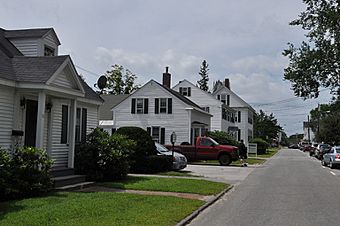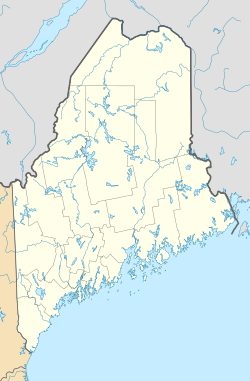Federal Street Historic District facts for kids
Quick facts for kids |
|
|
Federal Street Historic District
|
|

A view of Cleaveland Street in the district
|
|
| Location | Roughly bounded by Mason, Maine, College, and Federal Sts., Brunswick, Maine |
|---|---|
| Area | 65 acres (26 ha) |
| Architect | Multiple |
| Architectural style | Colonial Revival, Federal, Greek Revival |
| NRHP reference No. | 76000092 |
| Added to NRHP | October 29, 1976 |
The Federal Street Historic District is a special area in Brunswick, Maine. It's like a time capsule showing how the town grew. This district became important because Brunswick was a busy shipping center in the 1700s. Also, Bowdoin College, a famous school started in 1794, is right in the middle of it.
Besides the college, the district has many beautiful old houses. These homes are built in styles like Federal and later periods. They line Federal Street and Maine Street, connecting the college to Brunswick's downtown area. This important district was added to the National Register of Historic Places in 1976. This means it's officially recognized for its historical value.
Contents
Exploring Brunswick's Historic Past
The town of Brunswick officially started in 1737. Its economy first grew thanks to mills along the Androscoggin River. It also thrived because of ships trading goods by sea.
How Bowdoin College Shaped the Town
Bowdoin College was founded in 1794. Its first buildings were built on campus in 1799 and 1808. The town's shipping business faced big problems around 1807. This made the college even more important to Brunswick's growth.
Maine Street connects the college campus to the downtown area. This was the first main road in the area, built in 1717. Federal Street was created in 1803. It runs next to Maine Street.
Federal Street quickly became a popular place to live. Many fancy houses were built there. Cross streets also connected Federal Street to Maine Street. In 1826, a swamp along Maine Street was filled in. This created a park called Park Row. More grand houses were built along Park Row. The college even extended this park idea along its campus edge.
What You'll Find in the District
The historic district covers the main part of the Bowdoin College campus. It is bordered by Maine Street and College Street on the west and south. Silas Drive is on the east, and Bath Road is to the north.
The district then stretches north along Park Row and Federal Street to School Street. From there, it continues north on Federal Street to Mason Street. Most of the buildings in this area are homes.
Architectural Styles to Spot
You'll see many different building styles here. The most common ones are Federal, Greek Revival, and Colonial Revival. However, other styles from the 1800s and early 1900s are also present.
Famous Buildings and Homes
Some important buildings in the district are not part of the college. These include the First Parish Church. It was designed by the famous architect Richard Upjohn. Another is the Henry Boody House on Maine Street. This house has a unique Gothic Revival style.
You can also find the Parker Cleaveland House. This is now where the president of Bowdoin College lives. The Harriet Beecher Stowe House is also here. Harriet Beecher Stowe wrote the famous book Uncle Tom's Cabin.
On the college campus, you'll find Massachusetts Hall. This was the very first building built for the college. The Walker Art Gallery is another notable building on campus.



